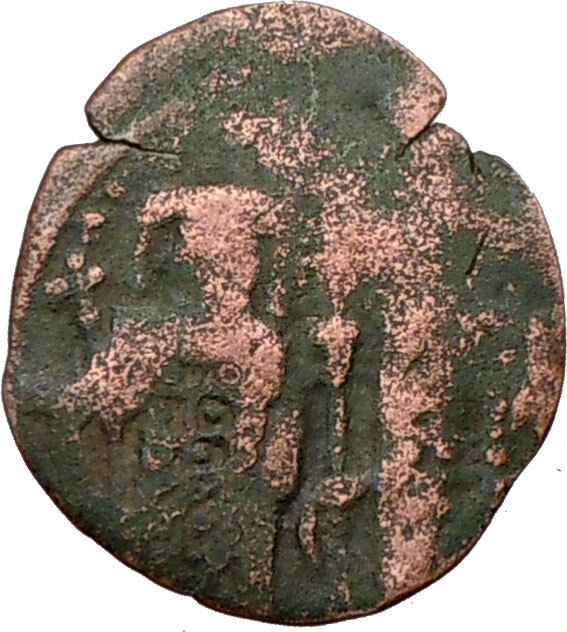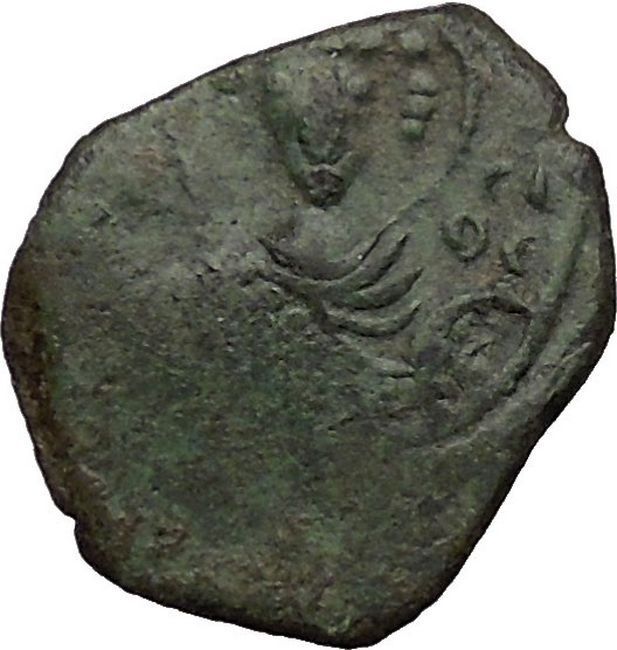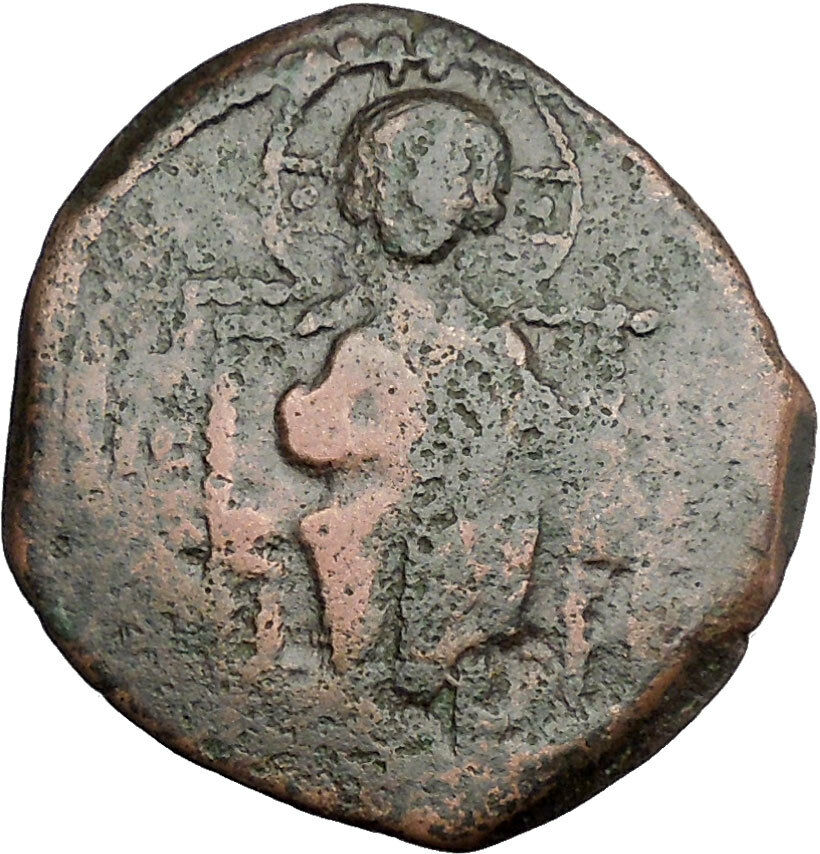|
Byzantine – Alexius III Angelus – Emperor: 8 April 1195 –
17 July 1203 A.D.
Billon Aspron Trachy 24mm (2.21 grams) Constantinople mint 1195-1203 A.D.
Reference: Sear 2011
Bust of Christ facing, beardless, wearing nimbus crown, pallium and colobium,
and
raising right hand in benediction; in left scroll.
Alexius on left and St. Constantine, bearded on right both standing
facing,
each wears crown, divitision and lorosand holds labarum
(emperor in right hand, saint in left).
Constantine.
Saint –
I the Great
Constantine
Ruling dynasties often exploit pomp and ceremony with the
use of regalia
:
crowns
,
robes
,
orb (globe) and
scepters
You are bidding on the exact
item pictured, provided with a Certificate of Authenticity and Lifetime
Guarantee of Authenticity.
Jesus of Nazareth (c. 5 BC/BCE – c. 30 AD/CE), also
referred to as Jesus Christ or simply Jesus, is the central figure
of
Christianity. Most
Christian denominations
venerate him as
God the
Son
incarnated
and believe that he
rose from the dead
after being
crucified
.
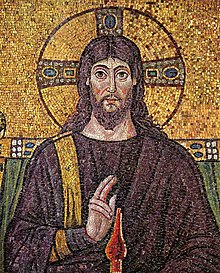
The
principal sources of information regarding Jesus are the four
canonical gospels, and most
critical scholars
find them, at least the
Synoptic Gospels, useful for reconstructing Jesus’ life and
teachings. Some scholars believe apocryphal texts such as the
Gospel of Thomas and the
Gospel according to the Hebrews
are also
relevant
.
Most critical historians agree that Jesus was a
Jew
who was regarded as a teacher and
healer
, that he
was baptized
by
John the Baptist, and
was crucified
in
Jerusalem
on the orders of the
Roman Prefect
Judaea,
Pontius Pilate, on the charge of
sedition
against the Roman Empire
. Critical Biblical scholars and
historians have offered competing descriptions of Jesus as a self-described
Messiah,
as the leader of an apocalyptic movement, as an itinerant sage, as a charismatic
healer, and as the founder of an independent religious movement. Most
contemporary scholars of the
Historical Jesus consider him to have been an independent,
charismatic founder of a Jewish restoration movement, anticipating an imminent
apocalypse. Other prominent scholars, however, contend that Jesus’ “Kingdom
of God” meant radical personal and social transformation instead of a
future apocalypse.
Christians traditionally believe that Jesus was
born of a virgin
:529–32
performed
miracles
,:358–59
founded
the Church
,
rose from the dead
, and
ascended
into
heaven,:616–20
from which he
will return
.:1091–109
Most Christian scholars today present Jesus as the awaited Messiah promised in
the
Old Testament and as God, arguing that he fulfilled many Messianic
prophecies of the Old Testament
. The majority of Christians
worship Jesus as the incarnation of God the Son, one of three divine persons of
a reject Trinitarianism
Trinity, wholly or partly,
believing it to be non-scriptural.
Alexios III Angelos (Greek:
Αλέξιος Γ’ Άγγελος) (c. 1153 – 1211) was
Byzantine emperor
from 1195 to 1203.
//
Early
life
Alexios III Angelos was the second son of Andronicos Angelos
and Euphrosyne Castamonitissa. Andronicus was himself a son of Theodora Comnene,
the youngest daughter of Emperor
Alexios I Komnenos
and
Irene Ducaena
. Thus Alexius Angelus was a member of the extended imperial
family. Together with his father and brothers, Alexios had conspired against
Emperor
Andronikos I Komnenos
(c. 1183), and thus he spent several years in exile in
Muslim courts, including that of
Saladin
.
His younger brother
Isaac II Angelos
, was threatened with execution under orders of their first
cousin once removed Andronicos I Comnenos on
September 11
,
1185. Isaac
made a desperate attack on the imperial agents and killed their leader
Stephanus Hagiochristophorites
. He then took refuge in the church of
Hagia
Sophia
and from there appealed to the populace. His actions provoked a riot,
which resulted in the deposition of Andronicus I, and the proclamation of Isaac
II Angelus as emperor. Alexius was now closer to the imperial throne than ever
before.
Reign
By 1190 Alexios Angelos had returned to the court of his
younger brother, from whom he received the elevated title of
sebastokratōr
. In 1195, while Isaac II was away hunting in
Thrace
, Alexius
was acclaimed as emperor by the troops with the conniving of Alexios’ wife
Euphrosyne Ducaena Camatera
. Alexios captured Isaac at
Stagira
in
Macedonia
, put out his eyes, and thenceforth kept him a close prisoner,
though he had been redeemed by him from captivity at
Antioch
and
loaded with honours.
To compensate for this crime and to solidify his position as
emperor, Alexios had to scatter money so lavishly as to empty his treasury, and
to allow such licence to the officers of the army as to leave the Empire
practically defenceless. He consummated the financial ruin of the state. In
1195, Holy Roman Emperor Henry VI forced Alexios III to pay him a tribute of
1,000 pounds of gold (originally 5,000 pounds of gold). The able and forceful
empress Euphrosyne Ducaena Camatera tried in vain to sustain his credit and his
court; Vatatzes, the favourite instrument of her attempts at reform, was
assassinated
by the emperor’s orders.
In the east the Empire was overrun by the
Seljuk Turks
; from the north
Bulgarians
and Vlachs
descended unchecked to ravage the plains of Macedonia and Thrace, and
Kaloyan of Bulgaria
annexed several important cities, while Alexius
squandered the public treasure on his palaces and gardens and attempted to deal
with the crisis through diplomatic means. The emperor’s attempts to bolster the
empire’s defenses by special concessions to Byzantine and Bulgarian notables in
the frontier zone backfired, as the latter built up regional autonomy. Byzantine
authority survived, but in a much weakened state.
Fourth
Crusade
Soon Alexios was threatened by a new and yet more formidable
danger. In 1202 the Western princes assembled at
Venice
launched
the Fourth Crusade
.
Alexios IV Angelos
, the son of the deposed Isaac II, had recently escaped
from
Constantinople
and now appealed to the crusaders, promising to end the
schism
of
East
and
West
, to pay for their transport, and to provide military support to the
crusaders if they helped him to depose his uncle and sit on his father’s throne.
The crusaders, whose objective had been
Egypt
, were
persuaded to set their course for Constantinople before which they appeared in
June 1203, proclaiming Alexios as emperor and inviting the populace of the
capital to depose his uncle. Alexius III took no efficient measures to resist,
and his attempts to bribe the crusaders failed. His son-in-law,
Theodore Lascaris
, who was the only one to attempt anything significant, was
defeated at Scutari
, and the siege of Constantinople began. Unfortunately for
Constantinople, Alexius III’s misgovernment had left the Byzantine navy with
only 20 worm-eaten hulks by the time the Crusaders arrived.
In July, the crusaders, led by the aged
Doge
Enrico Dandolo
, scaled the walls and took control of a major section. In the
ensuing fighting, the crusaders set the city on fire, ultimately leaving 20,000
people homeless. Alexios III finally took action, and led 17 divisions from the
St. Romanus Gate, vastly outnumbering the crusaders. But his courage failed, and
the Byzantine army returned to the city without a fight. His courtiers demanded
action, and Alexius promised to fight. Instead, that night (July 17/18), Alexios
III hid in the palace, and finally, with one of his daughters, Eirene, and such
treasures (1,000 pounds of gold) as he could collect, got into a boat and
escaped to
Develton
in Thrace
, leaving his wife and his other daughters behind. Isaac II, drawn
from his prison and robed once more in the imperial purple, received his son in
state.
Life
in exile
Alexius attempted to organize a resistance to the new regime
from
Adrianople
and then
Mosynopolis
, where he was joined by the later usurper
Murtzuphlus Alexius V Ducas
in April 1204, after the definitive fall
of Constantinople to the crusaders and the establishment of the
Latin
Empire
.
At first Alexios III received Alexius V well, even allowing
him to marry his daughter
Eudocia Angelina
. Later Alexios V was blinded and deserted by his
father-in-law, who fled from the crusaders into
Thessaly
.
Here Alexius III eventually surrendered, with Euphrosyne, to Marquis
Boniface of Montferrat
, who was establishing himself as ruler of the
Kingdom of Thessalonica
.
Trying to escape Boniface’s “protection”, Alexius III
attempted to seek shelter with
Michael I Ducas
, the ruler of
Epirus
, in 1205. Captured by Boniface, Alexius III and his retinue were sent
to Montferrat
, before being brought back to
Thessalonica
c. 1209. At that point the deposed emperor was ransomed by
Michael I of Epirus, who sent him to
Asia Minor
, where Alexios’ son-in-law
Theodore I Lascaris
of the
Empire of Nicaea
was holding his own against the Latins.
Here Alexios III conspired against his son-in-law after the
latter refused to recognize Alexius’ authority, and received the support of
Kay Khusrau I
, the
sultan
of
Rüm
. In the battle of
Antioch
on the
Maeander
in 1211, the sultan was defeated and killed, and Alexius III was
captured by Theodore Lascaris. Alexius III was relegated to a
monastery
at Nicaea
, where
he died later in 1211.
Family
By his marriage to
Euphrosyne Doucaena Camaterina
Alexios had three daughters:
-
Eirene Angelina, who married (1) Andronicus
Contostephanus, and (2) Alexius Palaeologus, by whom she was the grandmother
of Emperor
Michael VIII Palaeologus
.
-
Anna Angelina
, who married (1) the sebastokrator Isaac Komnenos,
great-nephew of emperor
Manuel I Comnenus
, and (2)
Theodore Lascaris
, emperor of Nicaea.
-
Eudocia Angelina
, who married (1) King
Prvovenčani Stefan I
of
Serbia
,
then (2) Emperor
Alexius V
, and (3)
Leo
Sgouros
, ruler of
Corinth
.

Labarum of Constantine I, displaying the “Chi-Rho” symbol above.
The labarum was a
vexillum
(military standard) that displayed
the “Chi-Rho”
symbol
☧
, formed from the first two
Greek letters
of the word “Christ”
—
Chi
and
Rho
. It was first used by the
Roman emperor
Constantine I
. Since the vexillum consisted of
a flag suspended from the crossbar of a cross, it was ideally suited to
symbolize the
crucifixion
of
Christ
.
Later usage has sometimes regarded the terms “labarum” and “Chi-Rho” as
synonyms. Ancient sources, however, draw an unambiguous distinction between the
two.
Etymology
Beyond its derivation from Latin labarum, the etymology of the word is
unclear. Some derive it from Latin /labāre/ ‘to totter, to waver’ (in the sense
of the “waving” of a flag in the breeze) or laureum [vexillum] (“laurel
standard”). According to the
Real Academia Española
, the related
lábaro
is also derived from Latin labărum
but offers no further derivation from within Latin, as does the Oxford English
Dictionary.[5]
An origin as a loan into Latin from a Celtic language or
Basque
has also been postulated. There is a
traditional Basque symbol called the
lauburu
; though the name is only attested from
the 19th century onwards the motif occurs in engravings dating as early as the
2nd century AD.
Vision of Constantine

A coin of Constantine (c.337) showing a depiction of his labarum
spearing a serpent.
On the evening of October 27, 312, with his army preparing for the
Battle of the Milvian Bridge
, the emperor
Constantine I
claimed to have had a vision
which led him to believe he was fighting under the protection of the
Christian God
.
Lactantius
states that, in the night before the
battle, Constantine was commanded in a dream to “delineate the heavenly sign on
the shields of his soldiers”. He obeyed and marked the shields with a sign
“denoting Christ”. Lactantius describes that sign as a “staurogram”, or a
Latin cross
with its upper end rounded in a
P-like fashion, rather than the better known
Chi-Rho
sign described by
Eusebius of Caesarea
. Thus, it had both the
form of a cross and the monogram of Christ’s name from the formed letters “X”
and “P”, the first letters of Christ’s name in Greek.
From Eusebius, two accounts of a battle survive. The first, shorter one in
the
Ecclesiastical History
leaves no doubt that
God helped Constantine but doesn’t mention any vision. In his later Life of
Constantine, Eusebius gives a detailed account of a vision and stresses that
he had heard the story from the emperor himself. According to this version,
Constantine with his army was marching somewhere (Eusebius doesn’t specify the
actual location of the event, but it clearly isn’t in the camp at Rome) when he
looked up to the sun and saw a cross of light above it, and with it the Greek
words
Ἐν Τούτῳ Νίκα
. The traditionally employed
Latin translation of the Greek is
in hoc signo vinces
— literally “In this
sign, you will conquer.” However, a direct translation from the original Greek
text of Eusebius into English gives the phrase “By this, conquer!”
At first he was unsure of the meaning of the apparition, but the following
night he had a dream in which Christ explained to him that he should use the
sign against his enemies. Eusebius then continues to describe the labarum, the
military standard used by Constantine in his later wars against
Licinius
, showing the Chi-Rho sign.
Those two accounts can hardly be reconciled with each other, though they have
been merged in popular notion into Constantine seeing the Chi-Rho sign on the
evening before the battle. Both authors agree that the sign was not readily
understandable as denoting Christ, which corresponds with the fact that there is
no certain evidence of the use of the letters chi and rho as a Christian sign
before Constantine. Its first appearance is on a Constantinian silver coin from
c. 317, which proves that Constantine did use the sign at that time, though not
very prominently. He made extensive use of the Chi-Rho and the labarum only
later in the conflict with Licinius.
The vision has been interpreted in a solar context (e.g. as a
solar halo
phenomenon), which would have been
reshaped to fit with the Christian beliefs of the later Constantine.
An alternate explanation of the intersecting celestial symbol has been
advanced by George Latura, which claims that Plato’s visible god in Timaeus
is in fact the intersection of the Milky Way and the Zodiacal Light, a rare
apparition important to pagan beliefs that Christian bishops reinvented as a
Christian symbol.
Eusebius’ description of the labarum
“A Description of the Standard of the Cross, which the Romans now call the
Labarum.” “Now it was made in the following manner. A long spear, overlaid with
gold, formed the figure of the cross by means of a transverse bar laid over it.
On the top of the whole was fixed a wreath of gold and precious stones; and
within this, the symbol of the Saviour’s name, two letters indicating the name
of Christ by means of its initial characters, the letter P being intersected by
X in its centre: and these letters the emperor was in the habit of wearing on
his helmet at a later period. From the cross-bar of the spear was suspended a
cloth, a royal piece, covered with a profuse embroidery of most brilliant
precious stones; and which, being also richly interlaced with gold, presented an
indescribable degree of beauty to the beholder. This banner was of a square
form, and the upright staff, whose lower section was of great length, of the
pious emperor and his children on its upper part, beneath the trophy of the
cross, and immediately above the embroidered banner.”
“The emperor constantly made use of this sign of salvation as a safeguard
against every adverse and hostile power, and commanded that others similar to it
should be carried at the head of all his armies.”
Iconographic career under Constantine

Coin of
Vetranio
, a soldier is holding two
labara. Interestingly they differ from the labarum of Constantine in
having the Chi-Rho depicted on the cloth rather than above it, and
in having their staves decorated with
phalerae
as were earlier Roman
military unit standards.
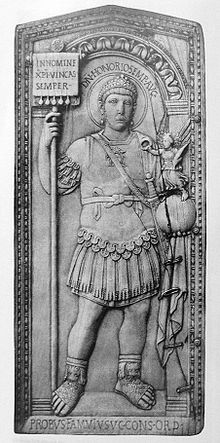
The emperor
Honorius
holding a variant of the
labarum – the Latin phrase on the cloth means “In the name of Christ
[rendered by the Greek letters XPI] be ever victorious.”
Among a number of standards depicted on the
Arch of Constantine
, which was erected, largely
with fragments from older monuments, just three years after the battle, the
labarum does not appear. A grand opportunity for just the kind of political
propaganda that the Arch otherwise was expressly built to present was missed.
That is if Eusebius’ oath-confirmed account of Constantine’s sudden,
vision-induced, conversion can be trusted. Many historians have argued that in
the early years after the battle the emperor had not yet decided to give clear
public support to Christianity, whether from a lack of personal faith or because
of fear of religious friction. The arch’s inscription does say that the Emperor
had saved the
res publica
INSTINCTV DIVINITATIS
MENTIS MAGNITVDINE (“by greatness of mind and by instinct [or impulse]
of divinity”). As with his predecessors, sun symbolism – interpreted as
representing
Sol Invictus
(the Unconquered Sun) or
Helios
,
Apollo
or
Mithras
– is inscribed on his coinage, but in
325 and thereafter the coinage ceases to be explicitly pagan, and Sol Invictus
disappears. In his
Historia Ecclesiae
Eusebius further reports
that, after his victorious entry into Rome, Constantine had a statue of himself
erected, “holding the sign of the Savior [the cross] in his right hand.” There
are no other reports to confirm such a monument.
Whether Constantine was the first
Christian
emperor supporting a peaceful
transition to Christianity during his rule, or an undecided pagan believer until
middle age, strongly influenced in his political-religious decisions by his
Christian mother
St. Helena
, is still in dispute among
historians.
As for the labarum itself, there is little evidence for its use before 317.In
the course of Constantine’s second war against Licinius in 324, the latter
developed a superstitious dread of Constantine’s standard. During the attack of
Constantine’s troops at the
Battle of Adrianople
the guard of the labarum
standard were directed to move it to any part of the field where his soldiers
seemed to be faltering. The appearance of this talismanic object appeared to
embolden Constantine’s troops and dismay those of Licinius.At the final battle
of the war, the
Battle of Chrysopolis
, Licinius, though
prominently displaying the images of Rome’s pagan pantheon on his own battle
line, forbade his troops from actively attacking the labarum, or even looking at
it directly.[16]
Constantine felt that both Licinius and
Arius
were agents of Satan, and associated them
with the serpent described in the
Book of Revelation
(12:9).
Constantine represented Licinius as a snake on his coins.
Eusebius stated that in addition to the singular labarum of Constantine,
other similar standards (labara) were issued to the Roman army. This is
confirmed by the two labara depicted being held by a soldier on a coin of
Vetranio
(illustrated) dating from 350.
Later usage

Modern ecclesiastical labara (Southern Germany).

The emperor
Constantine Monomachos
(centre
panel of a Byzantine enamelled crown) holding a miniature labarum
|












